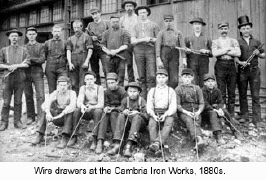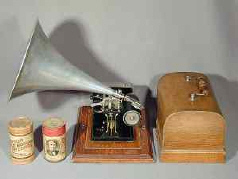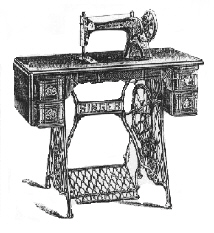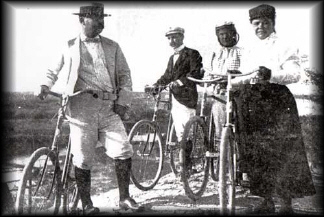Multiple Choice
Identify the
choice that best completes the statement or answers the question.
|
|
|
Natural Resources Fuel
Industrialization
After the Civil War, the United States was still
largely an agricultural nation. By the 1920s-a mere 60 years later-it had become the leading
industrial power in the world. This immense industrial boom was due to three major factors: a wealth
of natural resources, an explosion of inventions, and a growing urban population that provided
markets for new products.
| |
|
|
|
1.
|
What happened between the end
of the Civil War and the beginning of the 1920’s
a. | The U.S. went from being an
industrial country to an agricultural country | c. | The U.S. went from being a minor agricultural country to a major farming
country | b. | The U.S. became a rural country. | d. | The U.S. went from being a farming country to an industrial
country. |
|
|
|
2.
|
Which of the following is
not a reason for the U.S.
industrial boom.
a. | the growth of
agriculture | c. | natural
resources | b. | the growth of the cities | d. | new inventions |
|
|
|
BLACK GOLD
Crude oil is a
product that comes naturally from the earth. It can be used for fuel, lubrication and many other
products. Though eastern Native American tribes had made fuel and medicine from crude oil long before
Europeans arrived on the continent, they lacked the knowledge or expertise to develop it into an
industrial product. In 1840 the Canadian geologist Abraham Gesner realized that kerosene could
be used to light lamps and discovered how to distill it from oil or coal. It wasn't until
1859, however, when Edwin L. Drake successfully used a steam engine to drill for oil near Titusville,
Pennsylvania, that removing it from beneath the earth's surface became practical. This
breakthrough started an oil boom that spread to Kentucky, Ohio, Illinois, and Indiana.
Petroleum-refining industries arose in Cleveland and Pittsburgh as entrepreneurs rushed to transform
the oil into kerosene. | 
Gasoline, a byproduct of the refining process, originally was thrown away. But after
the automobile became popular, gasoline became the most important form of oil.
| | |
|
|
|
3.
|
Oil has many uses. What
motivated the oil boom after it became practical to extract it from the earth?
a. | The use of oil for in making
medicines | c. | The Drake system
for extracting oil from the earth | b. | The use of oil for lighting and later for
gasoline | d. | The use of oil by the
Indians |
|
|
|
4.
|
What does the term,
“Black Gold,” suggest?
a. | Oil can be extracted from the earth
just as gold is. | c. | Some thought oil
could be refined into gold nuggets | b. | The oil is black before it is refined | d. | Oil is valuable |
|
|
|
BESSEMER STEEL
PROCESS
Oil was not the only natural resource that was plentiful in the United
States. There were also abundant deposits of coal and iron to make steel. In 1887, prospectors
discovered iron ore deposits more than 100 miles long and up to 3 miles wide in the Mesabi Range of
Minnesota. At the same time, coal production was skyrocketing-from 33 million tons in 1870 to more
than 250 million tons in 1900.
As early as the 1600’s American settlers had been
producing iron and shaping into a wide range or products. Iron is a strong metal, but it is
heavy and tends to break and rust. It also generally contains other elements, such as carbon.
Removing the carbon from iron produces a lighter, more flexible, rust-resistant metal-steel. The raw
materials needed to make steel were readily available; all that was needed was a cheap and efficient
manufacturing process. |  The Bessemer process, developed independently by the British manufacturer Henry
Bessemer and the American iron maker William Kelly around 1850, soon became widely used. This
technique involved injecting air into molten iron to remove the carbon and transform it into steel.
By 1880, manufacturers were using the new method to produce more than 90 percent of the nation's
steel. In this age of rapid change and innovation, even the successful Bessemer process was bettered
by 1886. It was eventually replaced by the open-hearth process, with which manufacturers could
produce quality steel from scrap metal as well as from raw materials. The Bessemer process, developed independently by the British manufacturer Henry
Bessemer and the American iron maker William Kelly around 1850, soon became widely used. This
technique involved injecting air into molten iron to remove the carbon and transform it into steel.
By 1880, manufacturers were using the new method to produce more than 90 percent of the nation's
steel. In this age of rapid change and innovation, even the successful Bessemer process was bettered
by 1886. It was eventually replaced by the open-hearth process, with which manufacturers could
produce quality steel from scrap metal as well as from raw materials. | | |
|
|
|
5.
|
What is the Bessemer
process?
a. | A method of changing iron into steel
by injecting oxygen into the molten iron. | c. | A way of converting steel into iron bars | b. | A way of extracting iron ore from the
earth | d. | A way of using oil to refine iron
ore. |
|
|
|
6.
|
The above passage shows that
American entrepreneurial business people are good at using natural
resources and science to create industries that will make products that improve people’s
lives.
|
|
|
7.
|
What is the main idea of the
passage above?
a. | Steel is better than
iron | c. | The Bessemer process made steel
production practical | b. | Steel has more uses than iron | d. | America has abundant iron ore
resources |
|
|
|
NEW USES FOR STEEL
The
railroads, with their thousands of miles of track, became the biggest customers for steel, but
inventors soon found additional uses for it. Joseph Glidden's barbed wire and
McCormick's and Deere's farm machines helped transform the plains into the food
producer of the nation. Steel changed the face of the country as well, as it made innovative
construction possible. One of the most remarkable structures was the Brooklyn Bridge.
Completed in 1883, it spanned 1,595 feet of the East River in New York City. Its steel cables were
supported by towers higher than any man-made structure except the pyramids of Egypt. Like those
ancient marvels, the completed bridge was called a wonder of the world. Nonetheless, many people were
skeptical about its structural soundness. P. T. Barnum-the flamboyant showman-helped dispel their
doubts when he drove a herd of elephants across the bridge.
At
about this time, setting the stage for a new era of expansion upward as well as outward, William Le
Baron Jenney designed the first skyscraper with a steel frame-the Ilome Insurance Building in
Chicago. Before Jenney had his pioneering idea, the weight of buildings was supported entirely by
their walls. This meant that the taller the building, the thicker the walls had to be, so the height
was limited. Witli a steel frame to support the building, however, architects could build as high as
they wanted. As structures soared into the air, not even the sky seemed to limit what Americans could
achieve
| | | |
|
|
|
8.
|
What is the main idea of the
passage above?
a. | Steel has limited
uses | c. | B.T. Barnum helped to prove that
steel could be used to make bridges | b. | Steel helped to transform America into an industrial world
power. | d. | Steel had many uses in urban America but few uses in rural
parts of the country. |
|
|
|
9.
|
How did steel effect the
building industry in America?
a. | all are
true | c. | it allowed buildings to be
taller | b. | It allowed stronger buildings | d. | it made sky scrapers possible. |
|
|
|
Inventions Promote Change
By
capitalizing on natural resources and their own ingenuity, inventors changed more than the physical
shape of life. Their inventions affected the very way people lived and worked.
THE POWER OF
ELECTRICITY
In 1876, Thomas Alva Edison became a pioneer on the new industrial frontier
when lie established the world's first research laboratory in Menlo Park, New Jersey. Edison
perfected the incandescent light bulb there and followed up his invention with an entire system for
producing and distributing electrical power. Another inventor, George Westinghouse, added innovations
that made electricity safer and less expensive. Edison's company established power plants across
the country, while Westinghouse encouraged scientists to create applications for the new source of
energy. The harnessing of electricity completely changed the nature of business in America. By
189'0, electric power ran numerous machines, ranging from fans to printing presses. This
inexpensive, convenient source of energy soon became available in homes and spurred the invention of
increasing numbers of appliances. Electric streetcars made travel cheap and efficient and also
promoted the outward spread of cities. More important, electricity allowed manufacturers to locate
their plants wherever they wanted-not just near sources of power. This enabled industry to grow as
never before. Huge operations, such as the meat packing plants of Armour and Swift, and the efficient
processes that they used became the models for new consumer industries.
|

Thomas Edison and the
electric light

The first
phonograph | | |
|
|
|
10.
|
Why was electricity important
to business and industry?
a. | It was a cheap source of
power | c. | It allowed factories to be located
close to the source of the electricity, generated by rivers and
dams | b. | It was important to the development of the
railroads | d. | It helped to control labor
unions |
|
|
|
11.
|
When we think about the uses of
electricity, what modern invention is most like electricity.
a. | the
plow | c. | the
computer | b. | the modern farm | d. | the microwave oven |
|
|
|
12.
|
Which two men were important to
the development of electricity in the late 1800”s
a. | George Pullman and JP
Morgan | c. | none of these men were
important | b. | Bessimer and Drake | d. | Thomas Edison and George
Westinghouse |
|
|
|
NEW PRODUCTS AND LIFESTYLES
The country's expanding urban population provided a potential market for new
inventions and products. What people may not have foreseen, however, is how much their everyday lives
would change as a result of the innovations of the industrial age. Inventions such as the
typewriter and the telephone particularly affected office work and opened up new jobs for women.
Although women made up less than 5 percent of all office workers in 1870, by 1910 they
accounted for nearly 40 percent of the clerical work force. Most of these approximately 500,000
working women were single, white, native-born, and between 15 and 24.
New
inventions also had a tremendous impact on factory work, as well as on jobs that traditionally had
been done at home. Whereas most women had previously hand-sewn their families clothes, for example,
the invention of the sewing machine created a demand for professional garment workers. These
laborers-men, women, and children-worked long hours, often under unhealthy conditions.
 
Although machinery
freed other factory workers from backbreaking labor, many, realizing that they were easily
replaceable, felt a loss of self-worth and pride. While some workers lost power in the workplace as a
result of industrialization, they gained some power back as consumers in the marketplace. New
industries arose to advertise and promote consumer goods. Companies like American Tobacco, for
example, offered trading cards, premiums, and prizes with their products. The consumer had become an
important new force in American business. Overall, industrialization contributed to an improved
standard of living. By 1890, the average workweek had been reduced by about ten hours. Goods
such as phonographs, bicycles, and cameras provided new opportunities for recreation.
Industrialization changed American society forever.
| |
|
|
|
13.
|
Which statement below is
true?
a. | The new inventions and products
changed the lives of people in the country more than the cities | c. | The new inventions and products changed American culture
and society | b. | The new inventions and products changed made life harder for the average
citizen | d. | The new inventions and products had little effect on the
lives of average Americans |
|
|
|
14.
|
The new products and industries
gave factory workers a new sense of pride and dignity about the work that they
did.
|
|
|
15.
|
American workers got little
benefit from the industrialization of America
|
|
|
16.
|
What is the main idea of the
passage above?
a. | Industrialization caused basic
changes in American life and society | c. | Industrialization was detrimental to life in
America | b. | Industrialization benefited the rich but did not change the way ordinary
Americans lived. | d. | Industrialization had little effect
on American culture |
|
Matching
|
|
|
Edison's incandescent
light bulb, patented in 1880, was only one of several revolutionary developments. Another upheaval in
the workplace took place after Christopher Sholes invented the typewriter in 1867 and James Densmore
improved and marketed it in 1873. Next to the light bulb, however, perhaps the most dramatic
invention was the telephone, unveiled by Alexander Graham Bell and Thomas Watson in 1876. Although
coast-to-coast phone service did not begin until 1915 and was initially slow and expensive, this invention laid the groundwork
for a worldwide communications network a. | telephone | e. | James Densmore | b. | Alexander Bell and Thomas Watson | f. | George Westinghouse | c. | Christopher Sholes | g. | Andrew Carnegie | d. | Thomas Edison |
|
|
|
17.
|
invented the light
bulb
|
|
|
18.
|
invented the
typewriter
|
|
|
19.
|
improved and sold the
typewriter
|
|
|
20.
|
Invented the
telephone
|
|
|
21.
|
laid the groundwork for
worldwide communications network
|